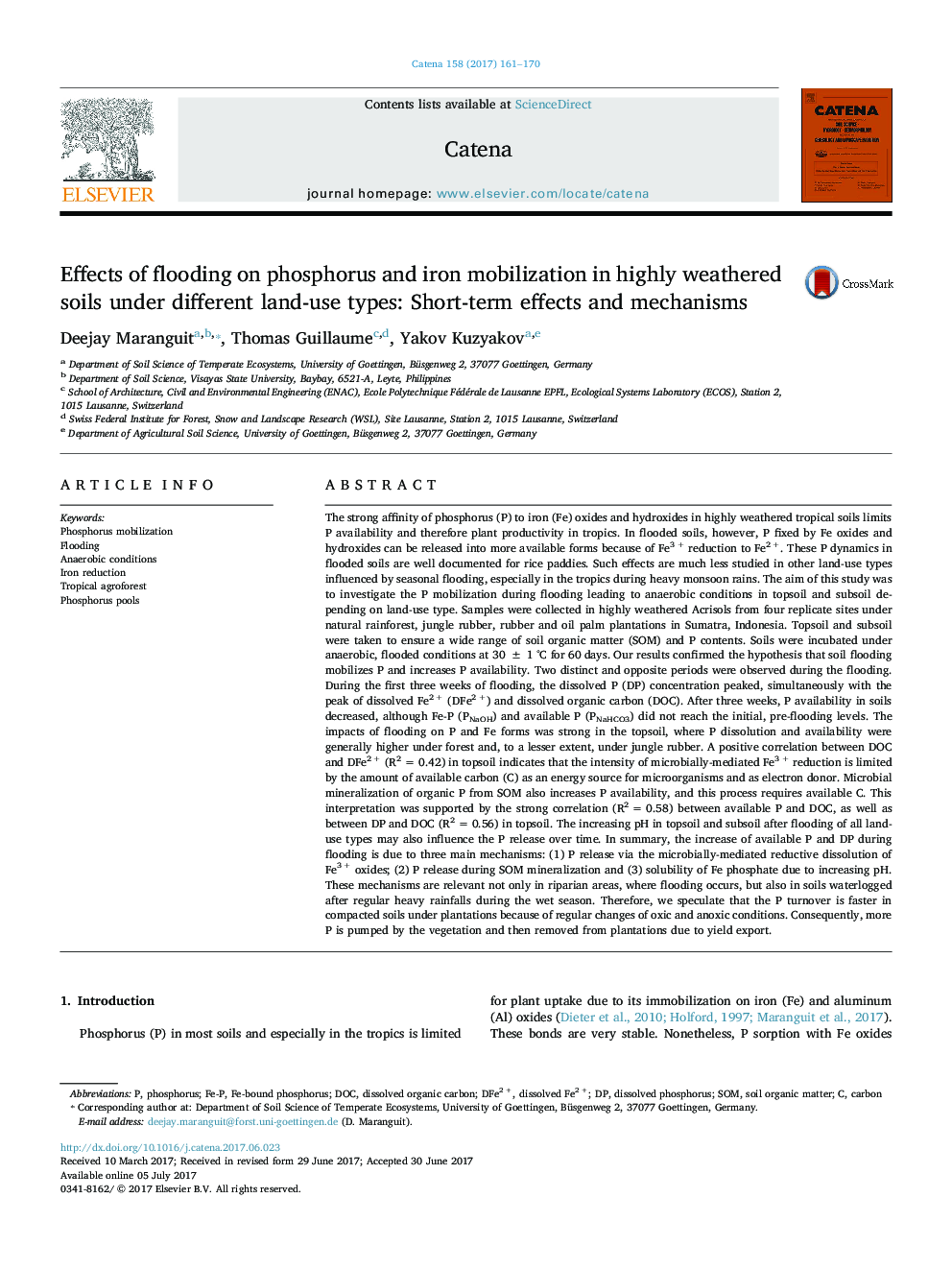| کد مقاله | کد نشریه | سال انتشار | مقاله انگلیسی | نسخه تمام متن |
|---|---|---|---|---|
| 5769901 | 1629196 | 2017 | 10 صفحه PDF | دانلود رایگان |
- How flooding influence P mobilization under different land-use types?
- Microbially-mediated Fe3Â + reduction is the key process behind the P release.
- Two distinct and opposite periods are observed upon flooding.
- High SOM in forest and jungle topsoil drives Fe3Â + reductions.
- Short-term P release is very important in highly weathered soil.
The strong affinity of phosphorus (P) to iron (Fe) oxides and hydroxides in highly weathered tropical soils limits P availability and therefore plant productivity in tropics. In flooded soils, however, P fixed by Fe oxides and hydroxides can be released into more available forms because of Fe3 + reduction to Fe2 +. These P dynamics in flooded soils are well documented for rice paddies. Such effects are much less studied in other land-use types influenced by seasonal flooding, especially in the tropics during heavy monsoon rains. The aim of this study was to investigate the P mobilization during flooding leading to anaerobic conditions in topsoil and subsoil depending on land-use type. Samples were collected in highly weathered Acrisols from four replicate sites under natural rainforest, jungle rubber, rubber and oil palm plantations in Sumatra, Indonesia. Topsoil and subsoil were taken to ensure a wide range of soil organic matter (SOM) and P contents. Soils were incubated under anaerobic, flooded conditions at 30 ± 1 °C for 60 days. Our results confirmed the hypothesis that soil flooding mobilizes P and increases P availability. Two distinct and opposite periods were observed during the flooding. During the first three weeks of flooding, the dissolved P (DP) concentration peaked, simultaneously with the peak of dissolved Fe2 + (DFe2 +) and dissolved organic carbon (DOC). After three weeks, P availability in soils decreased, although Fe-P (PNaOH) and available P (PNaHCO3) did not reach the initial, pre-flooding levels. The impacts of flooding on P and Fe forms was strong in the topsoil, where P dissolution and availability were generally higher under forest and, to a lesser extent, under jungle rubber. A positive correlation between DOC and DFe2 + (R2 = 0.42) in topsoil indicates that the intensity of microbially-mediated Fe3 + reduction is limited by the amount of available carbon (C) as an energy source for microorganisms and as electron donor. Microbial mineralization of organic P from SOM also increases P availability, and this process requires available C. This interpretation was supported by the strong correlation (R2 = 0.58) between available P and DOC, as well as between DP and DOC (R2 = 0.56) in topsoil. The increasing pH in topsoil and subsoil after flooding of all land-use types may also influence the P release over time. In summary, the increase of available P and DP during flooding is due to three main mechanisms: (1) P release via the microbially-mediated reductive dissolution of Fe3 + oxides; (2) P release during SOM mineralization and (3) solubility of Fe phosphate due to increasing pH. These mechanisms are relevant not only in riparian areas, where flooding occurs, but also in soils waterlogged after regular heavy rainfalls during the wet season. Therefore, we speculate that the P turnover is faster in compacted soils under plantations because of regular changes of oxic and anoxic conditions. Consequently, more P is pumped by the vegetation and then removed from plantations due to yield export.
181
Journal: CATENA - Volume 158, November 2017, Pages 161-170
